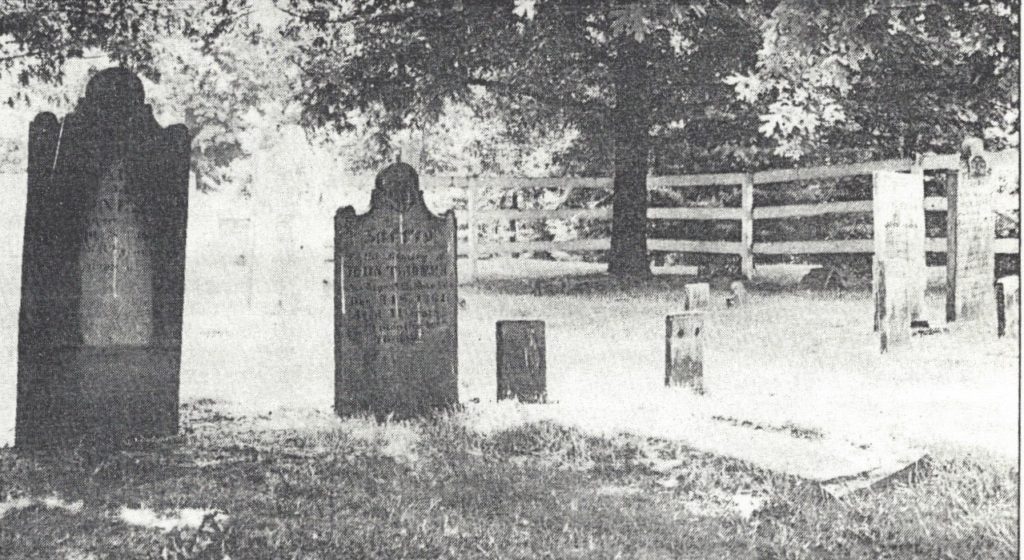By Regina Villiers. Originally published July 8, 1992 in The Suburban Life, added July 13, 2016.

The tombstone of Madeira pioneer John Jones tells of his service in the Revolutionary war.
Most of us in Madeira have ordinary yards with tree, shrubbery and grass. Some have flowers; a few have crabgrass. Most look much the same.
But Ted and Jackie Winslow on Rollymeade Drive have something unique in their front yard – a cemetery.
John Jones, the first settler in Madeira, lies buried in a family burying ground, located to the left of the Winslow driveway. The cemetery also contains the graves of Jones’ immediate family, as well as those of his descendants and their marriages.
Almost two centuries ago, in 1795, Jones came to the spot high on a ridge near the present-day Kenwood Country Club and carved out a home in the wilderness for his family.
Originally from Baltimore, Jones brought his family to Madeira by way a Ruddles Station in Kentucky, now called Ruddels Mills, between Paris and Cynthiana, where they had been living. Since interstate highways did not yet criss-cross the region, they probably came by way of the Licking River.
Jones, a soldier of freedom, had fought in the Revolutionary War for two intervals. His last period of service put him at Yorktown in 1791 when Cornwallis surrendered to General George Washington.
When Jones settled in the area that was to become Madeira, Indians lived on the next ridge over, now Indian Hill. Life was primitive and hard. He carved out a home for his family using nothing more than an axe.
In a 1987 interview, Jim DeMar talked about the quality of life at the time his great-grandfather Jones first arrived here.
“It was a rough life,” he said, “and the measure of a man was how well he could use an axe.”
Jones used an axe well, for he hewed from the forests a farm of about 150 acres where he lived the rest of his life growing fruit, wheat and the usual crops.
DeMar himself saw the work of the axe of John Jones. The Jones farm remained in the family, passing down to the DeMars who lived on it. A barn built by John Jones stood on the farm until 1956.
“It was an English-type log barn,” said DeMar, “with cribs on both ends and an open space in between. The logs were two to three feet in diameter, cut with an axe so smoothly that they looked sawed.”
DeMar lived on the farm until he grew up. The oldest of three brothers, he lived in the midst of history, hearing family stories interwoven with the history of Madeira and of this country.
He assumed the role of family historian. Starting with his mother, he can easily trace back his family to John Jones, relating names, dates and anecdotes to everyone.
His grandfather was Oliver Bell Jones, the son of James Daniel Jones, who was well – known and a member of the legislature.
Oliver Jones, the great-great-grandfather of DeMar, married Nancy Flinn. She was the first white baby ever seen by Tecumseh, the Shawnee Indian chief. Tecumseh marveled at the fair-skinned baby and later came bearing a gift for her, a pair of tiny, white Indian moccasins.
John Jones lived on his farm until his death, March 24, 1821, when he was 57 years and 15 days old, according to his tombstone. He remains undisturbed today in the same spot where he was buried.
The farm remained in his family. After him came his sons, their sons, and those on down to the DeMars, who lived there until progress eventually swallowed it in 1956.
When the farm sold, the DeMars retained ownership of the cemetery. It is still owned by Jim DeMar and his brothers.
The Winslows care for it, keeping it mowed, and they point out its history to any interested person who discovers it.
The cemetery contains many graves and ornate old tombstones. Although most are family graves, a few appear not to be. One grave, that of a woman, has only a woman’s first name on the marker.
Another grave is that of James Gray. He was a 25-year-old man from the Covenant Church who was passing through and stopped to spend the night at the Jones’ home. In the morning, he was dead, and they buried him in the family cemetery.
In 1961, Jim DeMar brought two acorns from the Wye Oak, which grows in Wye Oak State Park in Maryland, and planted them in the family cemetery as a memorial to his historical ancestor. He thought it a fitting memorial since Jones originally came from Maryland.
Two white oaks grow there today in the little cemetery on Rollymeade, protecting the resting place of the man who took the first giant step for Madeira two centuries ago.

The Winslows care for the cemetery, keeping it mowed, and they point out its history to any interested person who discovers it.